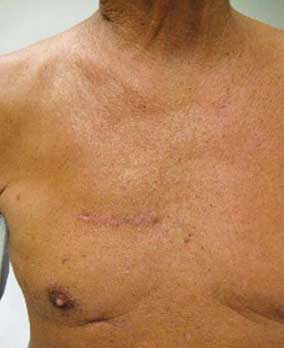Aortic Valve Repair/Replacement
Standard heart surgery typically requires exposure of the heart and its vessels through median sternotomy (division of the breast bone), one of the most traumatic aspects of traditional heart-related surgical procedures. Newly developed minimally invasive approaches, on the other hand, now offer access to the heart through small incisions and provide an array of patient and surgeon benefits.
For decades, the standard median sternotomy incision, with its straightforward physical access to and maximal visualization of all cardiovascular structures, has been the incision of choice for virtually every cardiac surgical procedure. More recently, and especially over the past decade, a combination of innovation, technology, and increasing patient demand for less invasive surgical procedures has directly challenged this standard. In response, surgical pioneers have harnessed engineering advances in circulatory systems, medical devices, operative instruments, and multimodality imaging, and have developed a variety of new approaches for use in cardiac surgery.
For many patients, a surgeon may decide that minimally invasive cardiac surgery is appropriate. Unlike conventional surgery, which requires a 10” to 12” incision and the use of a heart-lung machine, new minimally invasive approaches can be performed through a 2” to 3” incision placed between the ribs via the right or left chest and may not require heart-lung assistance.
The minimal incision approach has many applications and can now be applied to most cardiac surgical procedures. These procedures include aortic and mitral valve repair or replacement; tricuspid valve repair or replacement; double valve procedures (AVR/MVR and MVR/TVR); congenital heart defects (ASD); atrial myxoma resection; concomitant atrial fibrillation ablation; and single-vessel and multi-vessel coronary bypass grafting.

What is a MICS Valve procedure?
The minimally invasive AVR and MVR procedures are minimally invasive direct access approaches for the Aortic and Mitral valves. These procedures are performed under direct vision through right-sided mini thoracotomies and achieved by creating a 5 cm incision in the 2nd or 3rd intercostal space (AVR) or the 4th or 5th intercostal space (MVR). In addition, these incisions allow for double valve procedures (AVR/MVR and MVR/TVR), congenital heart defects (ASD), atrial myxoma resection, and concomitant atrial fibrillation ablation.
MICS Valve Surgery Applications & Potential Benefits
|
Applications for MICS Valve Procedures
|
 |
|
Potential benefits of MICS Valve Procedures
|


